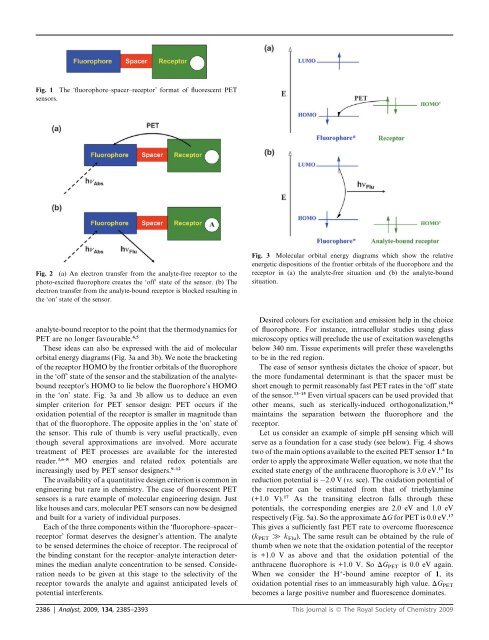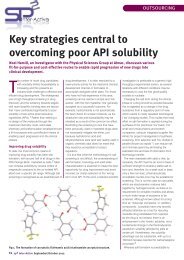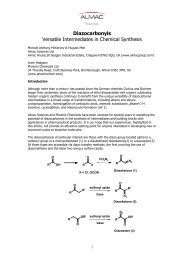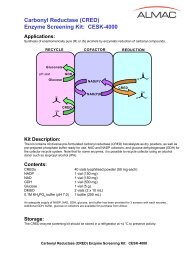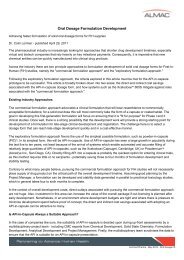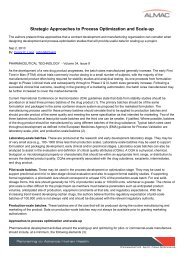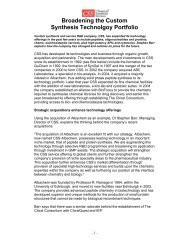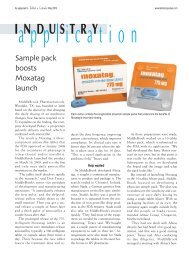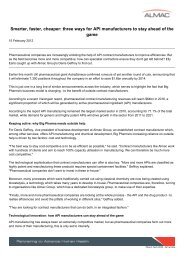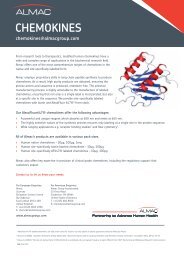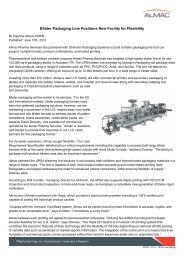Fluorescent PET (Photoinduced Electron Transfer) sensors ... - Almac
Fluorescent PET (Photoinduced Electron Transfer) sensors ... - Almac
Fluorescent PET (Photoinduced Electron Transfer) sensors ... - Almac
Create successful ePaper yourself
Turn your PDF publications into a flip-book with our unique Google optimized e-Paper software.
Fig. 1 The ‘fluorophore–spacer–receptor’ format of fluorescent <strong>PET</strong><br />
<strong>sensors</strong>.<br />
Fig. 2 (a) An electron transfer from the analyte-free receptor to the<br />
photo-excited fluorophore creates the ‘off’ state of the sensor. (b) The<br />
electron transfer from the analyte-bound receptor is blocked resulting in<br />
the ‘on’ state of the sensor.<br />
Fig. 3 Molecular orbital energy diagrams which show the relative<br />
energetic dispositions of the frontier orbitals of the fluorophore and the<br />
receptor in (a) the analyte-free situation and (b) the analyte-bound<br />
situation.<br />
analyte-bound receptor to the point that the thermodynamics for<br />
<strong>PET</strong> are no longer favourable. 4,5<br />
These ideas can also be expressed with the aid of molecular<br />
orbital energy diagrams (Fig. 3a and 3b). We note the bracketing<br />
of the receptor HOMO by the frontier orbitals of the fluorophore<br />
in the ‘off’ state of the sensor and the stabilization of the analytebound<br />
receptor’s HOMO to lie below the fluorophore’s HOMO<br />
in the ‘on’ state. Fig. 3a and 3b allow us to deduce an even<br />
simpler criterion for <strong>PET</strong> sensor design: <strong>PET</strong> occurs if the<br />
oxidation potential of the receptor is smaller in magnitude than<br />
that of the fluorophore. The opposite applies in the ‘on’ state of<br />
the sensor. This rule of thumb is very useful practically, even<br />
though several approximations are involved. More accurate<br />
treatment of <strong>PET</strong> processes are available for the interested<br />
reader. 3,6–8 MO energies and related redox potentials are<br />
increasingly used by <strong>PET</strong> sensor designers. 9–12<br />
The availability of a quantitative design criterion is common in<br />
engineering but rare in chemistry. The case of fluorescent <strong>PET</strong><br />
<strong>sensors</strong> is a rare example of molecular engineering design. Just<br />
like houses and cars, molecular <strong>PET</strong> <strong>sensors</strong> can now be designed<br />
and built for a variety of individual purposes.<br />
Each of the three components within the ‘fluorophore–spacer–<br />
receptor’ format deserves the designer’s attention. The analyte<br />
to be sensed determines the choice of receptor. The reciprocal of<br />
the binding constant for the receptor–analyte interaction determines<br />
the median analyte concentration to be sensed. Consideration<br />
needs to be given at this stage to the selectivity of the<br />
receptor towards the analyte and against anticipated levels of<br />
potential interferents.<br />
Desired colours for excitation and emission help in the choice<br />
of fluorophore. For instance, intracellular studies using glass<br />
microscopy optics will preclude the use of excitation wavelengths<br />
below 340 nm. Tissue experiments will prefer these wavelengths<br />
to be in the red region.<br />
The ease of sensor synthesis dictates the choice of spacer, but<br />
the more fundamental determinant is that the spacer must be<br />
short enough to permit reasonably fast <strong>PET</strong> rates in the ‘off’ state<br />
of the sensor. 13–15 Even virtual spacers can be used provided that<br />
other means, such as sterically-induced orthogonalization, 16<br />
maintains the separation between the fluorophore and the<br />
receptor.<br />
Let us consider an example of simple pH sensing which will<br />
serve as a foundation for a case study (see below). Fig. 4 shows<br />
two of the main options available to the excited <strong>PET</strong> sensor 1. 4 In<br />
order to apply the approximate Weller equation, we note that the<br />
excited state energy of the anthracene fluorophore is 3.0 eV. 17 Its<br />
reduction potential is 2.0 V (vs. sce). The oxidation potential of<br />
the receptor can be estimated from that of triethylamine<br />
(+1.0 V). 17 As the transiting electron falls through these<br />
potentials, the corresponding energies are 2.0 eV and 1.0 eV<br />
respectively (Fig. 5a). So the approximate DG for <strong>PET</strong> is 0.0 eV. 17<br />
This gives a sufficiently fast <strong>PET</strong> rate to overcome fluorescence<br />
(k <strong>PET</strong> [ k Flu ). The same result can be obtained by the rule of<br />
thumb when we note that the oxidation potential of the receptor<br />
is +1.0 V as above and that the oxidation potential of the<br />
anthracene fluorophore is +1.0 V. So DG <strong>PET</strong> is 0.0 eV again.<br />
When we consider the H + -bound amine receptor of 1, its<br />
oxidation potential rises to an immeasurably high value. DG <strong>PET</strong><br />
becomes a large positive number and fluorescence dominates.<br />
2386 | Analyst, 2009, 134, 2385–2393 This journal is ª The Royal Society of Chemistry 2009


